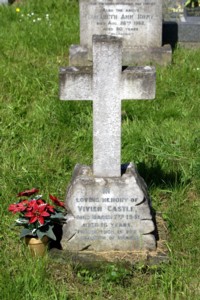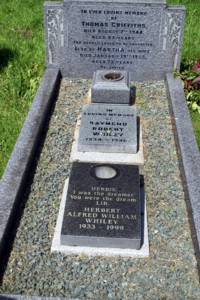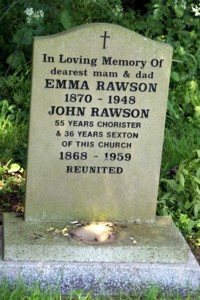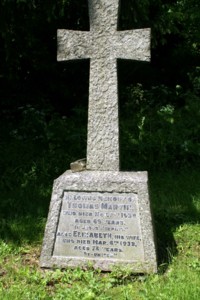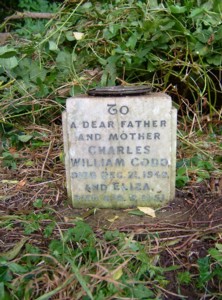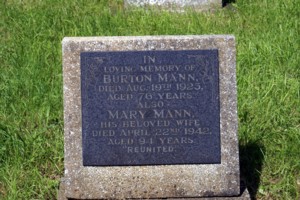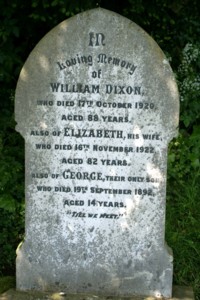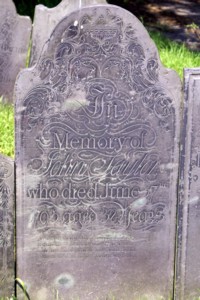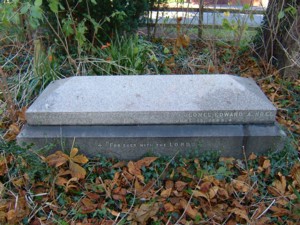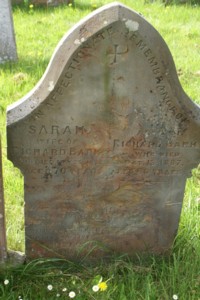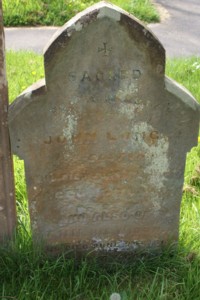
Graves and Inscriptions
All Saints Church and Churchyard
All Saints Church, one of the oldest buildings in the village, stands in Top Street and dates back to at least the 12th century. For it is recorded that in 1187 a certain Gabriel d’Elyston had the misfortune to be struck dead by lightening in the Church porch. The earliest known representation of the Church is in the beautiful Rampton Tapestry which was worked in 1632 by the Hyckes family, based on the John Speed map of 1616, and woven in a multitude of coloured wools. It formerly took up the space on two walls of the Museum of Textiles in Nottingham. One of its cameos portrays the old tower and spire of the Church.
Half way up the tower can be seen the initials RL, WL and IL below the Church clock on the quoin stones. They stand for members of the Lascelles family responsible for heightening the 13th century tower during the 1600s. The Lascelles were an old established family who settled in Elston and were Lords of the Manor a century earlier. The pretty Churchyard covered in primroses, snowdrops and crocuses in Spring contains over 400 headstones and memorials. In 1574 it was also being put to other uses. Adam Arnold of Elston was found guilty in the Archdeanery Court with others “ for that they annoye the churchyard by wynowynge corne therein” They were no doubt providing fodder for their animals.
This hyperlink will take you to the entry for All Saints Church, Elston which was prepared as part of the Southwell and Nottingham Church Project, set up in 1998 in conjunction with the University of Nottingham to provide an accurate historical and archaeological record for each church and church site within the Diocese.
http://southwellchurches.nottingham.ac.uk/elston/hintro.php
Burial Registers
The Church burial registers begin on 12th May 1572 and continue in a near unbroken run, to the present day. During 1694 to 1706 and 1783 to 1794 taxes were due on the registration of a burial so many burials went unrecorded. Between 1800 and 1899, 699 burials were recorded. There are of course literally thousands of villagers buried in the Churchyard whose headstone or wooden or stone markers have not survived the passage of time, such as John Chappel,
mentioned in the Burial Register in 1797 - “John Chappel, labourer, buried November aged 48 years. He died by the visitation of God in the field as he was returning from his work in the evening of November 1st.”
Nor should we forget those Elston villagers both adults and children who died in the Southwell Union Workhouse at Upton and who were brought back by horse and cart to be buried in the Churchyard. Villagers included Edward and Mary Broughton, William and Joseph Stubbs, Richard Walker, Elizabeth Pacey, Susan Ward and Jervis Pegge. Workhouse children included Sarah Sharp, William Cropper and William Fox.
Rectory
Since 1610, 11 Rectors of Elston have been buried in the Churchyard - the last being the Rev. Frederick Swire in 1886. In Georgian and Victorian times the old Rectory stood within the present Churchyard and fronted onto Top Street. In the early 1870s it was demolished and the site was consecrated for burial. The only surviving evidence of the former Rectory is a Georgian gate and railing within the Churchyard boundary on the east side, which at one time led into the Rectory garden.
Headstones and Memorials
There are some fine decorations incised on the headstones in the Churchyard. From the mid 19th century, the use of flowers on headstones as symbols of remembrance became very popular, especially the lily. The use of leaves like ivy reinforced the remembrance motif. Memorials take many forms and in some cases the only evidence of burial or memorial is shown by an unmarked cup, vase or bowl, some containing flowers from those who still remember who is buried there.
Early Headstones
The earliest surviving headstones have been removed from their original position and can be found in a row alongside the Church porch. The earliest dates from 1720 belonging to Anne Foottit, who was born in the reign of Charles II. Looking past the headstones to the Church wall one can just make out the outline of the original entrance to the Church which has long since been blocked up.
Monumental Masons
Some of the fine dark grey slate headstones appear to be of Swithland slate from Leicestershire and have a fine grained texture and look as if they were engraved only yesterday. These finely carved headstones are in part the work of Thomas Wood, a talented monumental mason and sculptor, buried in St Mary’s Churchyard in Bingham. His decorative mark can be found at the base of the headstone. He was born in Bingham in 1760 and died there in 1841. He married Mary Chettle in 1788 who predeceased him by a year. Other skilful masons of this period and whose work is represented in the Churchyard include Jones of Bingham, Wallis & Marshall of Newark, and Fretwell of Newark. To fully appreciate their artistry it is educational to look at the reverse side of the headstone to see the rough state of the stone before work began. There was no mass production in those days and production of each headstone involved a huge amount of skill and labour.
Cremations
Cremation ashes of villagers are buried in a separate plot on the east side of the Church near the gate with suitable memorial stones.
Lichens
When looking around the Churchyard take time to look at the various lichens which often form rich mosaics of yellow, red, orange, lime green, cream white etc, on the headstones and which add to the charm of the Churchyard, providing a perfect environment for their study. Many churchyards are found to have well over 100 species of the 1700 British species of these colourful fungal micro-organisms.
The Darwins
The Darwin family has played a major role in the village over the past three centuries, which is reflected in the number of memorials in the Church and outside. Due to subsidence, major work was carried out to the Church in 1859 when the north chancel wall and the Darwin Mausoleum, formerly located to the north of the Church, had to be taken down. The mausoleum was never rebuilt and the Darwin remains were re-interred, either under the Church floor or in the Churchyard.
Epitaphs
Finally, ther are many poignant epitaphs on the headstones, including that for William Dobbs (Sector C Row D Grave 17) who obviously suffered before his death in 1784 :
“Afflictions for nine years I bore
Physicians were in vain
Till death gave ease and God was pleased
To ease me of my pain”.
And of Elizabeth Elston (Sector C Row B Grave 2) who died at the tender age of just 16 years in 1811 and whose epitaph is a timely reminder to us all of our own mortality :
“All you who come my grave to see
As I am now so you must be”
It has been a difficult task to select just 24 headstones out of a total of over 400 within the Churchyard to encapsulate the lives of a cross section of village society from the agricultural labourer to the lord of the manor over the past 300 years. However, the lives of the following individuals have been significant to the village of Elston in a number of different ways as you will soon discover. A trail leaflet, incorporating a plan of the churchyard, can be obtained in the church.
1Vivien Castle - Factory Worker
Sector B Row A Grave 25
The plain simple Latin cross monument marks Elston’s only civilian casualty during the 2nd World War, killed in March 1941 at the age of 18 years during a bombing raid over Newark at the Ransome and Marles Ball Bearing Factory in which 41 people were killed. You will also find her name on the War Memorial in the Church porch.
2 Thomas Griffith - Cobbler
Sector B Row C Grave 13
Thomas lost a leg during the 1st World War and under a Government scheme was trained as a cobbler. Before the War he had been a groom to the Darwins at Elston Hall where he met and married Martha Richards of Elston. There is a large painted boot sign outside No.3 Mill Road, Elston, these days called "Cobbler's Cottage" in memory of him.
3 John Rawson - Skep Maker
Sector B Row F Grave 11
John practised his trade of basket making in the village. When enough baskets were made to fill a dray they were taken to the local railway station and sent to Grimsby for use in the fish trade. He lived at Sharah House in Elston Lane and may have been one of the last skep makers in the country. A skep was a wicker basket. He grew his own willow rods, prepared them, made his skeps and sold them as a finished product. The willow rods were grown in low marshy ground and there were two beds in Elston, one in the Little Scutchel and the other down Mill Road. Skeps had a variety of uses; some held coal, and others were malt skeps, feeding skeps, corn hoppers, and sometimes workmen’s lunch baskets. By the time he died the old craft had disappeared forever. John is recorded as Sexton in the All Saints Church accounts for 1913 being paid £6 5s 0d. His duties included grave digging, bell ringing and other jobs around the Church.
4 Thomas Martin - Secretary of the Order of Oddfellows
Sector B Row F Grave 10
Thomas lived and died at Ivy House in Low Street. He was Secretary of the Elston branch of the Order of Oddfellows, formed in 1833, and was a coal merchant and carrier by trade. The Oder of Oddfellows was originally a secret benevolent and social society and later became a Friendly Society. The earliest Lodges were supported by each member paying a penny on entering the Lodge and special sums were voted to any brother in need. In 1862 there were as many as 200 members. They financially supported the sick, widows and orphans and paid for funerals. In 1863, on their 30th anniversary, the Order of Oddfellows at the Village Annual Feast “assembled in the large club room at the Chequers Inn and proceeded in procession to the Church headed by the large Calverton Band.” The Annual Feast in Elston, traditionally held on the Sunday nearest to the 21st June, was also quite a lively affair and the Newark Advertiser for 1894 noted that “we believe for the first time in the annals of Elston, that upon this occasion there has been an entire absence of brawling”. A special cake called the Feast Cake was made for this occasion. Thomas’s coffin was borne on his dray and drawn by his faithful pony “Dick”, a companion for over 20 years. Thomas had been Churchwarden for over 31 years. His young son Leslie sadly appears on the War Memorial in the Church porch. He was only 19 years old and died in action serving with the South Wales Borderers during the 1st World War. He is buried next to his parents, Thomas & Elizabeth Martin.
5 Eliza Codd - Shop Keeper
Sector B Row G Grave 16
We had to include this headstone as Eliza Codd, true to her name, ran a very popular fish and chip shop in Elston on the site of The Limes in Low Street and many villagers would have liked her plaice !
6 Burton Mann - Village Constable
Sector B Row D Grave 14
The last Elston village constable was Burton Mann, who died in 1923. He lived in“Kindersley”, the last house in Mill Road on the left as you leave the village for Shelton and Sibthorpe. He was village constable from 1897. An unfortunate predecessor back in 1619 was fined 2s 6d for absence from his duties. Village constables houses were always built on the edge of a
village so that the constables could see who came and went. As part of his remuneration he was allowed rent free the use of a field called “The Constable’s Field” in Carrgate Lane. Duties included collecting various local taxes and levies, maintenance of the roads, repairs to bridges, cleaning of the River Devon, “dressing” the dykes and drainage ditches and maintaining the water course known as “The Willow Rundle,” which appears to have been a constant headache for the Constable. Control of “vermin” by payment of an award for the dead animal was a regular entry in the accounts - foxes, otters (1/- each), and sparrows (6d a dozen)
7 William Dixon - Village Pinder
Sector B Row E Grave 5
William was the last official Pinder in Elston and lived in “Hollydene“ in Elston Lane. He died in 1920 aged 88 years. He is described in the 1901 Census as a woodman and labourer. The Pinfold or Penfold was a pen, pound or enclosure which was usually round in shape. Its purpose was to hold stray cattle and horses until their owner claimed them. The owner paid
a fine to the Pinder for letting the animals stray and also a payment for the Pinder’s trouble in rounding them up and feeding them until collection. The site of the old Pinfold is readily identified by a high hawthorn hedge slightly protruding from adjacent properties and a wooden gate to secure the pound mid way along Pinfold Lane. A stream flowing from the other side of the lane was culverted through the old pound for the animals.
8 John Sumner - Benefactor
Sector B Row A Grave 4
John died at the village of Car Colston but his body was returned by horse and cart to Elston and was buried here on 12th October 1821. He was a cousin of Elizabeth Sumner (see No 12 below) as their fathers were brothers. John’s will set up a charity for the poor of Elston not in receipt of Parochial Relief to be distributed each year on his birthday, 21st December. This charity continues to this day.
9 John Taylor - Butcher
Sector B Row D Grave 3
John was the village butcher and lived with his wife in Low Street. His will dated 7th June 1793 has survived. The set of slate headstones for the Taylor family are particularly fine and the inscriptions appear as sharp and as clear today as they would have been back in the 18th century when they were originally carved. They appear to be of Swithland slate from Charnwood Forest in Leicestershire. It is noticeable that from the middle of the 18th century a practice became prevalent of cutting more deeply into the slate, which is very evident here. The designs on the Taylor headstones, though similar to each other, are not duplicated exactly.
10 Anne Foottit - Weaver
Sector C Row H Grave 6
This is the earliest surviving headstone dating back to November 1720. The Foottit family name spelt in various ways eg. Footitt. The family name appears regularly in the records of Elston and East Stoke. Early Georgian wills indicate that some were weavers, including Anne and her husband Anthony who was Chapel Warden in 1723. A Richard Foottit (1701-1741), nephew of Anne and Anthony, is also remembered in an unusual memorial by the west window in the Church where he describes himself as “Clark”, i.e. Parish Clerk. In 1729 the west window had been blocked up and was eventually reglazed and reopened. His name marks the occasion when the window was reopened.
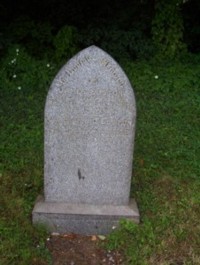
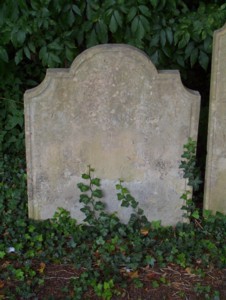
11 Richard Elston - Labourer
Sector C Row B Grave 4
Richard, an agricultural labourer according to the 1881 Census, was born in 1801 and married Hannah, a local girl. He was actively involved in the creation of the Independent Primitive Methodist Chapel in 1840 in Elston, which was situated at the corner of the Little Scutchel and Low Street, now a private house called The White House. In 1808 the Methodist lay preacher, Hugh Bourne, was expelled from the movement and he and his 200 followers became known as Primitive Methodists, so called because John Wesley in 1790 referred to himself as “a primitive Methodist.” Bourne’s followers were called "Ranters" because of the lively nature of the sermons preached by their Ministers. The headstone reveals that Richard was the father of James Elston, the Hull police pensioner. The Hull City police records show that James joined as a policeman in 1868 and retired in December 1894. If you look closely at the foot of his headstone even the monumental mason was called Elston - very much the case of keeping it in the family.
12 Elizabeth Sumner - Benefactor
Sector C Row A Grave 8
Elizabeth was the daughter of Robert Sumner and Alice Sharp of Farndon. She was born in Elston in 1719 and died, unmarried, at Farndon in 1799. By her will she set up a charity still going to this day “for the benefit of poor people who by sickness or any other accident be in danger of coming under common relief. Such poor persons to be nominated and chosen yearly by the Churchwardens and Overseers of the Poor.” The Sumners were an old established Elston family having been resident from at least the 16th century. They were farmers and bakers and lived in Low Street. In the 1650s they lived in a
house at the bottom of the “Big Scutchel” (‘scutchel’ being a peculiarly Nottinghamshire/Lincolnshire word meaning a passage way) which stretches from Low Street to Top Street. A Richard Sumner was one of the Chapel Wardens of Elston in 1668.
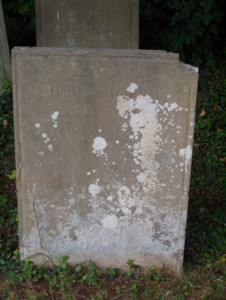

13 John Piper - Landlord of the Chequers Inn
Sector C Row B Grave 1
John became the licensee of the Chequers Inn in Toad Lane on his father’s death in 1767. Twenty years later John met a sudden and tragic death in June 1788 when the loaded gun he was cleaning accidentally went off. His distraught mother died later the same year and in her will left “the annual sum of six shillings to be distributed at Christmas in either bread or money to 12 poor persons of Elston.” This charity still continues in the village to this day. Sadly Mary Piper’s headstone has not survived.
14 William Wood Rose - Overseer of the Poor
Sector C Row A Grave 1
The 1861 Census describes William as a farmer employing two labourers and a boy. He was Overseer of the Poor for the Parish of Elston along with William Rowbotham (Sector B Row C Grave 2). Their responsibility lay in setting the Poor Rate, its collection, and distribution of relief to those villagers in need. The tradition of the village supporting its poor was firmly established from Saxon times. William is shown on the Electoral Register as living in Top Street and owning 72 acres of land. The death of his two young children in 1857 is shown on the adjoining headstone.
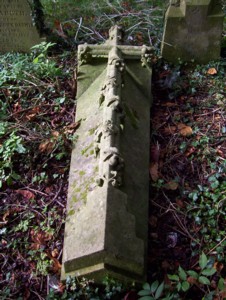
15 William Brown Darwin - Lord of the Manor
Sector C Row G Grave 3
William succeeded his uncle, Robert Waring Darwin, and inherited the Elston Estate and lived at Elston Hall. He was married to Elizabeth de St Croix and had 7 children, 4 of whom died young. There are sad memorials to three of them inside the Church in the north aisle - William who died aged 13, Jane aged 14 and Elizabeth aged 15. William’s wife Elizabeth was said to be a “bit of a tartar” and had the appalling habit of giving enormous doses of camomile to her unfortunate children. Mrs Dorothea Darwin was told by her father in law that “she not only dosed his family but the whole village”. William commissioned the renovation and alteration of the Church in 1841 to its present form. His tomb, a low monument with gabled top, comprises an eye-catching and elaborately carved stone cross encrusted with clumps of ivy - no doubt inspired by the Gothic Revival.
16 Colonel Edward Andrew Noel - Gentleman at Arms
Sector C Row H Grave 1A
Edward married Sarah Darwin, daughter of William Brown Darwin. He was Deputy Lieutenant of Nottinghamshire, Gloucestershire and Derbyshire as well as a JP. He was admitted to the Honourable Corps of Gentlemen at Arms and was Colonel of the 1st Gloucestershire Royal Volunteers. His grandfather was Sir Gerard Noel, 2nd Baronet and his grandmother was Baroness Barham. As a Gentleman at Arms he would have worn the uniform of a Dragoons Guards officer of the 1840s and carried during ceremonies a long battle axe over 300 years old. Gentlemen at Arms acted as a bodyguard to the Monarch and were the Corps was formed in 1509 by Henry VIII. In Edward’s day the duties were purely ceremonial. The Gentlemen attended the Sovereign at various ceremonies including visits by Heads of State, the State Opening of Parliament and the ceremonies of the various orders of chivalry including the Order of the Garter. Edward died in Derbyshire in 1899 and his body was returned to Elston for burial.

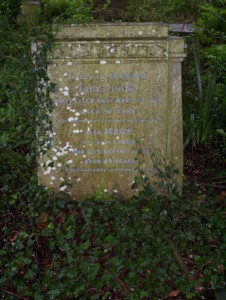
17 Robert Bateman - Butler at Elston Hall
Sector C Row I Grave 7
Robert worked as a butler in Berkeley Square, London. He later worked as a butler to the Darwins at Elston Hall. After he retired from their service he lived at in Low Street and named his house "Berkeley Cottage" in memory of his days in London. His sister Mary, also buried here, was lady’s maid to Miss Eleanor Darwin. Robert was Churchwarden at All Saints Church and Parish Councillor. It is said that he wrote in “an excellent copper plated hand”.
18 Jabez Bond - Saddler and Harness Maker
Sector C Row K Grave 3
Jabez is a biblical name and means “pain” in Hebrew. He was born in Sproxton and became a saddler, collar and harness maker in Elston. He was also an Assistant Overseer of the Poor for Elston, East Stoke and Flintham, a census enumerator, tax collector and Clerk to the Parish Council. He appeared in the Trades Directories between 1879 and 1900. In the 1901 Census he is shown as married to Mary. Their son, Charles Jabez Bond, was also a harness maker and is buried nearby. His saddler’s shop was on the site of The Limes and he lived at Berkeley Cottage in Low Street. Jabez also collected the weekly contributions for the Pig Club from villagers. Most people kept a pig and if it was ill or died the Pig Club money paid for the vet or helped to replace it. Some people kept two pigs and sold one for bacon, which paid for the upkeep of the both of them. Any money left over from the Club was distributed at Christmas. See 24 below.
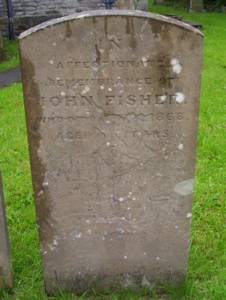
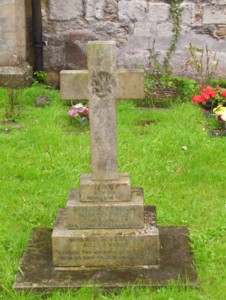
19 John Fisher - Blacksmith
Sector C Row R Grave 5
John was one of two blacksmiths living and working in Elston in 1832. He may have worked at the Old Forge in Low Street close to his home. The 1851 Census describes him as “Blacksmith employer and journeyman”. In the Churchwarden accounts for 1840 for All Saints Church we find John being paid for “11 grates to the Church spouts” and receiving the sum of 9 shillings. Unlike John Fisher there were also unruly Elston blacksmiths and we are told that one of them, James Bell, was called before the Church Court in 1634 for saying to the Rector of All Saints, Richard Gymney, “You are a swaggerer”. One could think of worse insults but obviously in 1634 Elston this was beyond the pale. The records do not record the punishment which befell the blacksmith.
20 Richard Manterfield - Chorister at All Saints Church
Sector C Row Q Grave 3
The plain Latin cross monument is for Richard, a chorister of All Saints Church who died tragically at the age of 9 years in 1881. He lived in Elston Hall and was the son of William, coachman to the Darwins and his wife Charlotte. The number of infants and children dying remained high until the 1930s. This grave bears witness to this sad fact as well as the neighbouring one to Charles Hopkinson, another chorister at the Church, who died aged only 13 years in 1884. Scarlet fever, measles, TB and typhoid took their toll of adults as well as children.
21 John Lee - Miller
Sector A Row F Grave 1
John is described as a miller in 1868 and his family was responsible for building the windmill, known locally as “the Black Giant,” in Mill Road in 1845. It remained in the family until John’s death in 1901 before passing to the Darwins. There were at one time two windmills in the village. The other lay on the south side of Elston Lane where Mill Hill House is now and Thomas Rowbotham was the miller between 1832 and 1853.
22 Richard Bark - Labourer
Sector A Row D Grave 3
This headstone and others adjacent to it record the lives of the Bark family, many of whom were labourers living in Top Street in the 19th century. Records a century earlier show the family in a more prosperous light as farmers in Elston. Could this be the same Richard Bark shown in receipt of 6 shillings distributed to “the Poor of the Chapel of Elston” from the John Sumner Charity in December 1861 along with Thomas Bark ? A John Bark was shown as a Churchwarden of All Saints in 1786. Another member of the family, William, was sentenced to transportation for a crime committed in Car Colston in 1822. He was subsequently pardoned, having served 5 years on a prison hulk. However in 1830 William was again convicted of a further crime and transported to Australia for 7 years. His name does not appear again in the Elston records after this date so it is quite possible he remained in Australia. Transportation came to an end in 1868. From 1787 to 1868 over 160,000 men, women and children were transported to the colonies and over 30% died during the journey. After
completion of their sentence each man or woman would receive 40 acres of land, seed, tools and provisions to settle the land. If he survived the journey and the harsh conditions, William would have started a new life in New South Wales, far away from the green fields of Elston.
23 John Long - Schoolmaster
Sector A Row B Grave 3
John was appointed schoolmaster by Robert Waring Darwin and the Rector in 1812 and held that position for nearly 50 years. He was noted for his skill in playing the violin. He was required to teach 4 children, usually boys selected either by Mr Darwin or the Rector, teaching them reading, writing, and arithmetic. All books had to be purchased by the parents. He lived rent free in Sharah House (then called Rose Cottage) in Elston Lane, which was attached to the school house. In 1858 there were three schools in the village, The Dame School for Infants, the Grammar School, of which John was schoolmaster, and the New National School. A predecessor of John Long, a schoolmaster called Richard Warwick, was buried in the Churchyard in 1670 after a burial service at Elston Chapel.
24 Richard Whitworth - Landlord of the Chequers Inn
Sector A Row A Grave 9
Born in 1800, Richard was landlord of the Chequers Inn in Toad Lane and his children Richard and Caroline succeeded him. He is shown on the Electoral Register of 1839, living in Top Street, with 17 acres. He opened a butcher’s shop in 1850 next door to supplement his income. Most cottages had a pig sty and some good brick built examples are still standing. Dependency on this animal was very real as they provided nutritious meals throughout the long hard winter. The pigs were well fed on kitchen waste or pig meal from Gash’s Mill. Richard would be involved, normally around 11th November (Martinmas Day), to kill the pigs, which had been “fatted up” during the year. The visit of the Pig Sticker set off a chorus of screaming from the animals about to be slaughtered. As one villager recalled “Nothing was wasted, the intestines were cleaned and used for sausages, the fat rendered down and was stored in the bladder for lard and the blood for sausage”.

